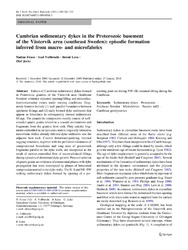Cambrian sedimentary dykes in the Proterozoic basement of the Västervik area (southeast Sweden): episodic formation inferred from macro- and microfabrics
Zeitschrift: International Journal of Earth Sciences, 2010100, 4: 741 - 752
DOI: https://doi.org/10.1007/s00531-009-0508-3
Persistent URL: http://resolver.sub.uni-goettingen.de/purl?gldocs-11858/6954
Persistent URL: http://resolver.sub.uni-goettingen.de/purl?gldocs-11858/6954
Friese, Nadine; Vollbrecht, Axel; Leiss, Bernd; Jacke, Olaf, 2010: Cambrian sedimentary dykes in the Proterozoic basement of the Västervik area (southeast Sweden): episodic formation inferred from macro- and microfabrics. In: International Journal of Earth Sciences, Band 100, 4: 741 - 752, DOI: 10.1007/s00531-009-0508-3.
 |
Dokument öffnen: |
Fabrics of Cambrian sedimentary dykes formed in Proterozoic granites of the Västervik area (Southeast Sweden) evidence repeated opening/filling and mineralisation/cementation events under varying conditions. Diagnostic features include (1) wall-parallel boundaries between epiclastic fillings and (2) early formed dyke sediments that appear as lithoclasts in subsequently formed sedimentary fillings. The psammitic components mostly consist of well-rounded quartz grains related to a coastal environment and fragments from the granitic host rock. Platy calcitic fragments embedded in the epiclastic matrix originally formed as microveins within already-lithified dyke sediments and the adjacent host rock. Convex downward-pointing, internal sagging structures, together with the preferred orientation of compositional boundaries and long axes of grains/rock fragments parallel to the dyke walls, are interpreted as the result of suction-controlled flow of unconsolidated fillings during episodes of downward dyke growth. Pressure solution of quartz grains are evidence of extensional phases with dyke propagation that were interrupted by phases of horizontal compression normal to the dyke walls. The N–S and NE–SW striking sedimentary dykes formed by opening of a pre-existing joint set during NW–SE oriented rifting during the Cambrian.
Statistik:
ZugriffsstatistikSammlung:
- Geologie [933]

